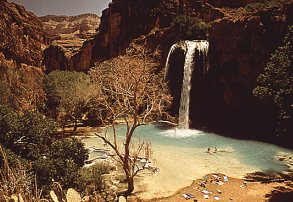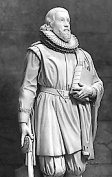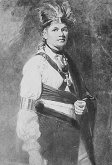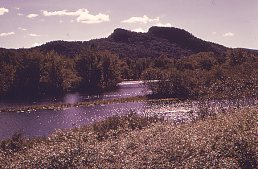The Puritan Origins of the American Wilderness Movement
J. Baird Callicott, University of North Texas
Priscilla Solis Ybarra, Rice University
©National Humanities Center
|
|
(part 3 of 4)
GUIDING STUDENT DISCUSSION
 |
|
 |
Havasu Falls, Arizona
| National Archives
|
"Wilderness is, in short, a
'socially constructed' idea."
|
|
 |
When the topic of wilderness comes up for discussion, many students will entertain fantasies of
themselves alone or with a small group of good friends—properly (and stylishly) outfitted by L.L. Bean
and Land's End, of course—searching for themselves, for God (or the Oversoul if they have been
exposed to Emerson and Thoreau), or communion with Nature, or for the properly romantic setting for
consummating a sexual attraction in a wilderness setting. Images of backpacking down soft trails,
leading into shady glens, surrounding deep pools of crystal water, beneath towering, rumbling falls will
dance in their heads. Only the most habitually critical students are likely to get what you're talking
about when you suggest to them that "wilderness" is not a name like "mountain" or "river" that refers
to common features of nature, but a lens through which nature is perceived. Wilderness is, in short, a
"socially constructed" idea. Your job is to help them deconstruct it.
| U.S. Capitol |  |
John Winthrop
|
|
|
 |
First, ask students to imaginatively put themselves in the place of the first generation of
Puritans—learned in the words of the Old Testament, but utterly ignorant of the ecology of the New
World—set down on the upper Mid-Atlantic coast of a little-known continent the size of which they
could not begin to imagine. None of their expectations were borne out by the stark "reality"
confronting them. It's getting on toward winter—gray, cold, damp, dark,
 |
|
 |
Magalloway River
| National Archives
|
|
 |
and devoid of sustenance if
you are used to looking at British grain fields, kitchen gardens, and barn yards. And much of what does
animate the landscape is terrifying—wolves, a variety of feline predators, and worst of all, unpredictable
peoples with incomprehensible languages, customs, rituals, and beliefs. A dismal, dark, howling, and
hideous wilderness indeed! Some students might protest, and, with the 20/20 vision of hindsight and
youthful self-confidence, insist that they would have been able to appreciate the New England landscape
for its richness and beauty. Here a bit of Morton might reinforce, but also sober their sense of
adventure and receptivity. For Morton was a truly adventurous and receptive sojourner in the
landscape of early contact and colonization, but even his attitude was far from that of a contemporary
anthropologist and ecologist.
| National Archives |  |
Iroquoian chief
|
|
|
 |
Then, ask your students imaginatively to put themselves in the place of the Native Americans whose
beloved and often contested homeland the seventeenth-century English settlers had invaded and
intended to possess. The landscape is friendly, teeming with sustenance—easily harvested shellfish in
the estuaries,
 |
|
 |
Magalloway River
| National Archives
|
|
 |
abundant winter game in the woods for skilled and experienced hunters who know its
habits and wiles, salmon runs in the springtime streams, wild summer and fall fruits, and communal
village gardens of maize, squash, and beans. If one could somehow translate the word "wilderness" into
an Iroquoian tongue, this place would not be a wilderness from the Indian point of view.
Now, put these two exercises in imagination side by side. Maybe ask two students to come forward and
role-play. Ask one to be a Puritan pilgrim and the other an American Indian standing shoulder to
shoulder surveying the landscape from a high prominence. You get one country and two worlds: a
terrifying, strange, wild world for one; a hospitable, familiar (and place-named), well-known world for
the other.
TeacherServe Home Page
National Humanities Center
7 Alexander Drive, P.O. Box 12256
Research Triangle Park, North Carolina 27709
Phone: (919) 549-0661 Fax: (919) 990-8535
Revised: July 2001
nationalhumanitiescenter.org |





